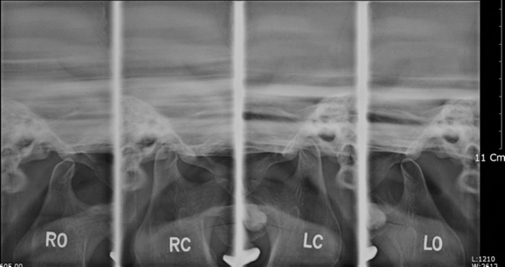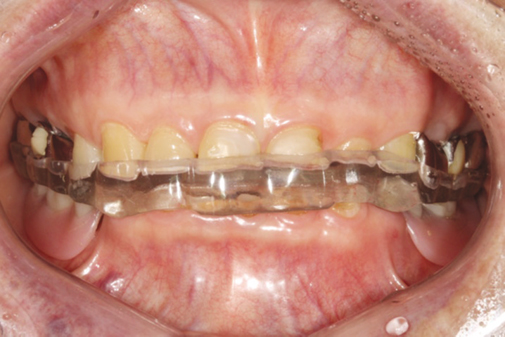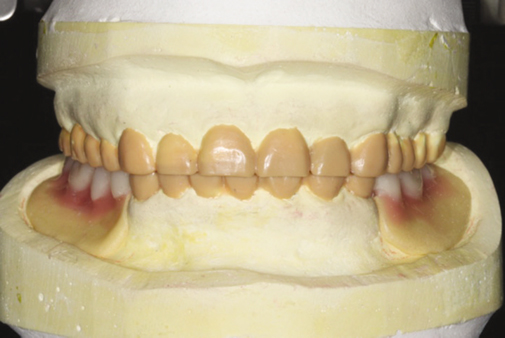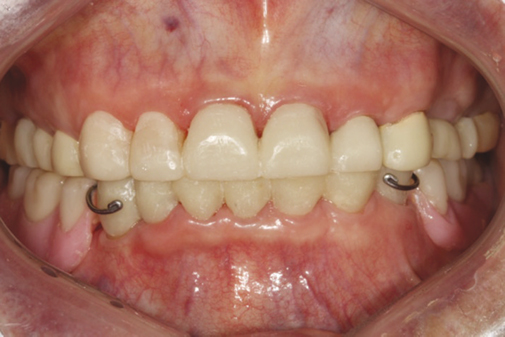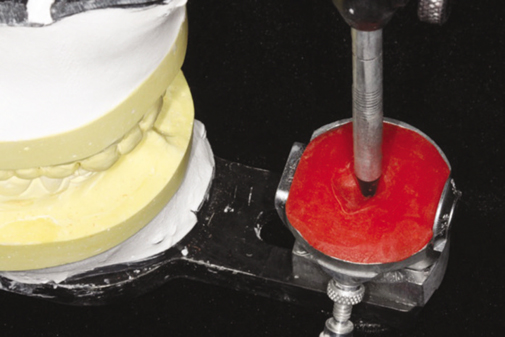J Adv Prosthodont.
2010 Sep;2(3):106-110. 10.4047/jap.2010.2.3.106.
Full mouth rehabilitation of the patient with severely worn dentition: a case report
- Affiliations
-
- 1Department of Prosthodontics, School of Medicine, Ewha Womans University, Seoul, Korea. prosth@ewha.ac.kr
- KMID: 2118116
- DOI: http://doi.org/10.4047/jap.2010.2.3.106
Abstract
- The severe wear of anterior teeth facilitates the loss of anterior guidance, which protects the posterior teeth from wear during excursive movement. The collapse of posterior teeth also results in the loss of normal occlusal plane and the reduction of the vertical dimension. This case report describes 77-year-old female, who had the loss of anterior guidance, the severe wear of dentition, and the reduction of the vertical dimension. Occlusal overlay splint was used after the decision of increasing vertical dimension by anatomical landmark, facial and physiologic measurement. Once the compatibility of the new vertical dimension had been confirmed, interim fixed restoration and the permanent reconstruction was initiated. This case reports that a satisfactory clinical result was achieved by restoring the vertical dimension with an improvement in esthetics and function.
MeSH Terms
Figure
Cited by 1 articles
-
Full mouth rehabilitation of a severely worn dentition using intraoral scanner and the CAD/CAM double scanning technique
Se-Na Yoon, Jung-Suk Han, In-Sung Yeo, Hyung-In Yoon
J Korean Acad Prosthodont. 2020;58(1):67-76. doi: 10.4047/jkap.2020.58.1.67.
Reference
-
1. Turner KA, Missirlian DM. Restoration of the extremely worn dentition. J Prosthet Dent. 1984. 52:467–474.2. Smith BG. Toothwear: aetiology and diagnosis. Dent Update. 1989. 16:204–212.3. Prasad S, Kuracina J, Monaco EA Jr. Altering occlusal vertical dimension provisionally with base metal onlays: a clinical report. J Prosthet Dent. 2008. 100:338–342.4. Dawson PE. Functional Occlusion - From TMJ to smile design. 2008. 1st ed. New York: Elsevier Inc.;430–452.5. Jahangiri L, Jang S. Onlay partial denture technique for assessment of adequate occlusal vertical dimension: a clinical report. J Prosthet Dent. 2002. 87:1–4.6. Dahl BL, Krogstad O, Karlsen K. An alternative treatment in cases with advanced localized attrition. J Oral Rehabil. 1975. 2:209–214.7. Dahl BL, Krogstad O. Long-term observations of an increased occlusal face height obtained by a combined orthodontic/prosthetic approach. J Oral Rehabil. 1985. 12:173–176.8. Dahl BL. The face height in adult dentate humans. A discussion of physiological and prosthodontic principles illustrated through a case report. J Oral Rehabil. 1995. 22:565–569.9. Hemmings KW, Darbar UR, Vaughan S. Tooth wear treated with direct composite restorations at an increased vertical dimension: results at 30 months. J Prosthet Dent. 2000. 83:287–293.10. Darbar UR, Hemmings KW. Treatment of localized anterior toothwear with composite restorations at an increased occlusal vertical dimension. Dent Update. 1997. 24:72–75.11. Sato S, Hotta TH, Pedrazzi V. Removable occlusal overlay splint in the management of tooth wear: a clinical report. J Prosthet Dent. 2000. 83:392–395.12. Windchy AM, Morris JC. An alternative treatment with the overlay removable partial denture: a clinical report. J Prosthet Dent. 1998. 79:249–253.13. Hemmings KW, Howlett JA, Woodley NJ, Griffiths BM. Partial dentures for patients with advanced tooth wear. Dent Update. 1995. 22:52–59.14. Yunus N, Abdullah H, Hanapiah F. The use of implants in the occlusal rehabilitation of a partially edentulous patient: a clinical report. J Prosthet Dent. 2001. 85:540–543.15. Ganddini MR, Al-Mardini M, Graser GN, Almog D. Maxillary and mandibular overlay removable partial dentures for the restoration of worn teeth. J Prosthet Dent. 2004. 91:210–214.16. Hempton TJ, Dominici JT. Contemporary crown-lengthening therapy: a review. J Am Dent Assoc. 2010. 141:647–655.17. Hoyle DE. Fabrication of a customized anterior guide table. J Prosthet Dent. 1982. 48:490–491.18. Johansson A, Johansson AK, Omar R, Carlsson GE. Rehabilitation of the worn dentition. J Oral Rehabil. 2008. 35:548–566.19. Brown KE. Reconstruction considerations for severe dental attrition. J Prosthet Dent. 1980. 44:384–388.20. Witter DJ, Van Elteren P, Käyser AF, Van Rossum GM. Oral comfort in shortened dental arches. J Oral Rehabil. 1990. 17:137–143.
- Full Text Links
- Actions
-
Cited
- CITED
-
- Close
- Share
- Similar articles
-
- Mandibular full arch rehabilitation of a patient with severely worn dentition after completion of maxillary full arch rehabilitation
- Full mouth rehabilitation using zirconia crown in severe worn dentition: a case report
- Full-mouth rehabilitation with increasing minimum vertical dimension in the patient with severely worn dentition and deep bite
- Complete mouth rehabilitation with vertical dimension increase in patient with extremely worn dentition
- Full mouth rehabilitation of patient with excessively worn dentition from multiple factors: a case report


